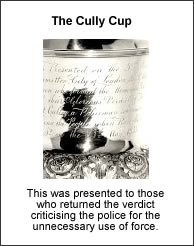A brief history from 1829-1900
The Metropolitan Police force was created in 1829 by Sir Robert Peel (from which the old nickname “Peelers” originated) to address the high levels of crime and disorder in London.
The establishment had been worried about the Mob since the 1780 Gordon Riots when around 50,000 rioters were dealt with by the army, who shot 285 of them dead.

Far from being welcomed by a grateful public, the first policemen were regarded with deep mistrust and suspicion. People thought their civil liberties would be infringed and that the policemen would be spying on them.
Just four years later, this ill-feeling resulted in the death of P.C. Culley, the second constable to be killed on duty. He was stabbed in Coldbath Fields in a pitched battle between an estimated 2000 or more policemen and a meeting of the National Union of the Working Classes.
The 17-man jury ignored the coroner’s direction that a verdict of wilful murder be returned. The foreman told the coroner “we are firmly of the opinion that if they [the police] had acted with moderation the deceased would not have been stabbed”.
Far from cries of outrage that a policeman had been murdered in the course of his duty, a pewter cup was presented to the foreman as a reminder of the “glorious verdict of justifiable homicide”.
A year later the Met was described as “one of the most valuable modern institutions” in its efforts to combat crime, law and order.
The size and influence of the Metropolitan Police increased as they incorporated the Bow Street Runners, Marine Police and in 1842 formed a Detective Division, which in 1856 was increased to 10 men. Continued attempts to take over the City of London police failed.
As well as London (an area which kept expanding, creating more Met divisions) the force was in the 1860s given responsibility for policing the Royal Dockyards.
In the early days of the force, drunkenness amongst the constables was a cause of much concern and the reason for many of them being dismissed.
During the 1870s and 80s the force expanded their geographical territory, the first rules for preserving murder crime scenes were drawn up and the first police strike occurred.
1888 presented the Met with their greatest challenge, the yet unsolved murders credited to the unidentified “Jack the Ripper” which saw their efforts to catch him much criticised and ridiculed by the press, the public, Parliament and Queen Victoria.
In 1893 PC George Cooke was convicted and hanged for “the murder while on duty”, of Maud Merton, a prostitute he had been seeing. [ See sidebar article. ]
By the end of the 1890s candidates to join the police needed:
To be between 21-27 years old
Be 5’ 9”
Read, write legibly with correct spelling
Be generally intelligent
Physically healthy (men with flat feet or facial deformities were rejected)
PC Baldwin’s murder in 1898 was regarded differently from that of PC Culley just over 30 years earlier. There was a demand for policemen to be armed.
By 1900 The Met had grown from 3,000 men to 16,000, to police 7 million Londoners.
Little Nell
© Little Nell 2008
The Wormwood Scrubs Murder
While working in the Bow Street District Division, PC George Samuel Cooke became involved with a prostitute called Maud Merton. At first all went well between the two of them, but when Cooke tired of the relationship and tried to put an end to it, Maud threatened to tell his superior officers.
The situation became worse when Cooke was transferred to the Xth Division and became engaged to a young servant girl. On hearing of the engagement, Maud renewed her threats and on the night of the 6th June, while Cooke was on duty patrolling the perimeter of Wormwood Scrubs prison, they argued and Cooke bludgeoned Maud to death with his truncheon, which he then buried in the garden at his lodgings.
Cooke was charged with the murder shortly afterwards and his trial began at the beginning of July. On the 8th he was found guilty of murder by the Jury who also recommended mercy on the grounds of provocation but, Mr Justice Hawkins in his sentencing underlined the viciousness of the attack and stated that, while the Home Secretary would be approached for mercy, he doubted very much that it would be granted.
As expected the Home Secretary denied him mercy and, at 9 o’clock on the morning of July 25th, PC George Cooke was executed at Newgate, barely two months after murdering Maud.
Georgette
© Georgette 2008.
SOURCES
“Criminal Islington: the story of crime and punishment in a Victorian suburb”, edited by Keith Sugden. Islington Archaeology & History Society 1989.
